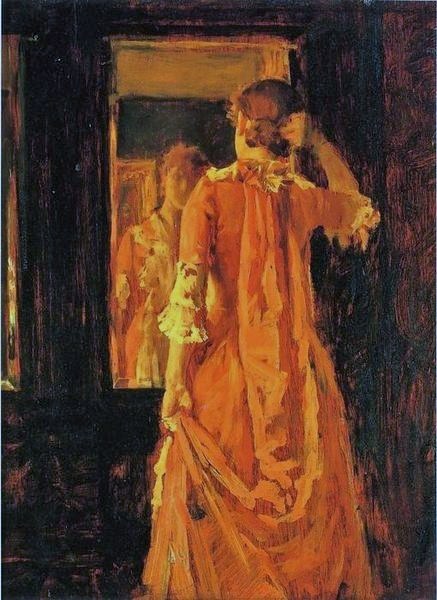William Merritt Chase, Young Woman Before a Mirror. Public domain, via Wikimedia Commons.
When I get dressed, I become a philosopher-king—not in the sense of presiding over utopia, but in the sense of trying to marry politics and intellect in the perfect imitation of God. Political considerations might include: destination, company, self-image, self-regard, in-group and out-group arrangements. The intellectual ones might involve: the weather, the way I am always too cold no matter the weather, the subway, the blisters on my feet, the laundry. When I get dressed, I have never once considered whether to add a belt. Belts have never struck me as a thing to “add”; pants either need a belt or they don’t. But some girls like to “add” one, and that’s fine too. I do consider the area where a belt might go—that stretch of midsection where the top of my pants meets the bottom of my shirt. It means a lot (to me), where exactly on my body that convergence takes place. If it’s lower, say a few inches below my belly button, I might get slouchier when I stand around, might remember being a kid in the early aughts, and I might in general feel more weighed down by the pull of gravity. If it’s higher up on my torso, I sit up straighter in my chair, I prefer a more substantial shoe, I feel more compact, more professional, more like my mother.
When I get dressed, I think about the last time I washed my hair and whether I’m going to wear my glasses or not. I am too much of a germophobe to wear shoes in the house, so I have no choice but to imagine the theoretical addition of a shoe, which I’ll put on last, when everything else is already a foregone conclusion. Lately, I can’t stop buying socks; it’s a compulsion. Wearing socks with no holes, that haven’t yet become limp from untold numbers of wash-and-dry cycles, has recently become crucial to my feeling of being able to face the world. On the other hand, I wear the same bra every single day, and it is such an essentially bland item of clothing that it feels like putting on my own skin. Nights are a different story: it’s important to invite spontaneity into your evening in whatever way you can.
When I get dressed I am confronted with the protean ecosystem of everything I have, everything I want, and why I have things that I’m not sure I want. Some things that I almost never buy, no matter their purported “quality,” are: dresses or skirts with slits, matching sets, sweaters with puffy shoulders, V-neck cardigans, Birkenstocks, tops where the pattern is printed only on the front and not the back, jeans that are ripped at the knees, and anything described as a “tunic.” I’m not saying that you shouldn’t buy these things, I’m just telling you that I don’t want to. One thing I do want is to compose an ode to the tank top. The tank top is the shortest route to luxury—one of the only designer items affordable to those of us on a budget. A beautiful sweater or a handbag from wherever is out of the question, but you might, if it’s your birthday or you take an extra freelance gig, treat yourself to the flimsiest, paper-thinnest $200 tank top, knowing that the construction and the material is worth a fraction of that and feeling unreservedly that every dollar of difference is a delicious indecency. There’s nothing noble about being frivolous. But it can be wonderful to choose to be part of something bigger than you, which has a history and an artistry and—in the best case scenario—a point of view. It can even be worth an inordinate amount of your hard-won money. Anyways, when I get dressed, I reign over my little shelf of needlessly fancy tank tops and I feel alive.
There are some eternal quandaries. If I have to wear a sweater, a button-down shirt becomes untenable. (I don’t ever pop the collar neatly above my sweater, though I have nothing against prep, per se). If I have to wear tights, the prospect of choosing a skirt and a top and a sweater and socks and shoes becomes monstrous to me. If I choose to inflict tights upon myself, I will end up in a longer skirt so that I can avoid at least fifty percent of the lines that all those layers will generate on my body. I want to wear a pointed-toe kitten heel, but it feels impossible to do. If I have to wear a hat for warmth, I usually don’t.


















